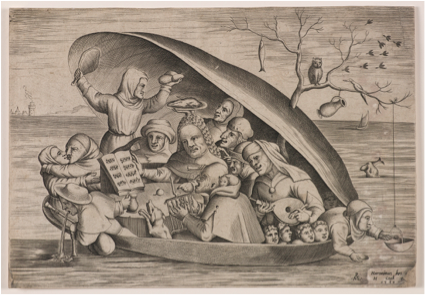Beyond Bosch: The Afterlife of a Renaissance Master in Print

Beyond Bosch: The Afterlife of a Renaissance Master in Print
January 23, 2016 – May 8, 2016
Harvard Art Museums, Cambridge, Massachusetts
In celebration of the 500th anniversary of the death of Hieronymus Bosch (c. 1450-1516), the Harvard Art Museums present an exhibition that focuses on the development of the Netherlandish artist’s posthumous reputation. Visitors drawn in by the fame of the Bosch name might find it surprising that there is no work by the master included, but that is exactly the point of the show, which argues that it is not only by his visionary paintings that Bosch commands a reputation as one of the most fanciful, creative, and indeed hauntingly nightmarish artists of his age. Rather, this intimate exhibition is devoted to the later phenomenon of the Bosch brand, formed by the inventive Bosch-style prints, which proliferated around the mid-sixteenth century. Reinterpreting and distributing Bosch’s unique pictorial language far beyond Flanders (modern day Belgium), none of the prints are reproductions of Bosch’s paintings, yet most of the plates were inscribed with a credit to Bosch as their inventor. Then, as now, the hook was “Bosch.”
The invitation to explore these prints is set into play by an unknown etcher’s interpretation of Bosch’s iconic Tree-Man (c. 1600). Excerpted from the Garden of Earthly Delights, this hybrid creature is given an added dimension through the insertion of spectators who point to Bosch’s enigmatic creation. Their outward glance at the beholder heightens the self-conscious act of one’s own viewing of this print and the works that follow. Later in the exhibition, visitors encounter the Tree-Man again, a time-tested figure translated in a 1935 lithograph by M.C. Escher, the most recent print in the exhibition.
The story of the Bosch legacy begins with his little-known contemporary and townsman, Allart du Hameel, who executed twelve rare engravings that adopt Bosch’s pictorial language; one of which, his Saint Christopher (late 15th-early 16th century), should not be missed. On the adjoining wall a flurry of torture-loving demons unleash a hellish onslaught, assailing saints, hermits, and the viewer. In a witty curatorial narrative, the next wall appropriately features two scenes of the Last Judgment, one of which prominently claims Bosch as inventor ignoring that it is actually derived from du Hameel. This section succeeds in raising Allart du Hameel out of the shadow of the Bosch brand, reinserting his agency and pivotal importance into the narrative of Bosch’s legacy in print.

Visitors learn that this boom for Boschian prints was largely due to the seizure of a market opportunity by the print publisher Hieronymus Cock nearly a half century after the artist’s death. Through his Antwerp publishing house, Aux Quatre Vents (At the Sign of the Four Winds), Cock worked with a team of artists and engravers to reimagine Bosch’s pictorial language. Pieter Bruegel the Elder’s iconic work, Big Fish Eat Little Fish (1557), is but one of these prints emanating from Cock’s business which advertise Bosch as their inventor. Again, “Bosch” sells.
Bruegel developed the reputation of a “second Bosch,” but his well-known contribution seems curiously downplayed in the exhibition. While contemporary Belgian artist Antoine Roegiers’s animated journey brings Bruegel’s drawings for The Seven Deadly Sins series to life, the glowing widescreen competes with the allegorical designs that inspired it, including the prints of Anger and Lust (both 1558), which are crowded on the adjacent wall. Roegiers’ engrossing epic transports the viewer into Bruegel’s Bosch-inspired world where lustful demons copulate and one unfortunate man rides upon the back of a monster while he endures lashings from a demonic crowd on a march toward a dismal end.
The exhibition concludes with a long wall of prints highlighting other playful inventions that take a Bosch-inspired look at Carnival scenes such as Pieter van der Heyden’s wayward Merrymakers in a Mussel Shell (1562). This print is among twenty-nine of the thirty-five on display which are on loan, mostly from a single private collection. The gathering accounts for a significantly wide breath of images that to varying degrees find their conception in the mode of Bosch. Harvard’s collection supplied only six of the prints, along with one unattributed, delicate drawing that depicts the head of a peasant woman drafted in the manner of Bosch with an incredible economy of line.

Beyond Bosch succeeds as it delights and disturbs, enveloping viewers in these printed worlds to which Bosch, in part, owes his lasting legacy. Harvard is the second venue for the exhibition, which was previously installed at the Saint Louis Art Museum (SLAM). The exhibition is co-curated by Marisa Bass, assistant professor of art history and archaeology at Washington University in Saint Louis, and Elizabeth Wyckoff, curator of prints, drawings, and photographs at SLAM. A catalogue accompanies the exhibition, contributing to the scholarship dedicated to this Bosch-branded year.